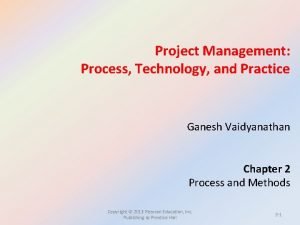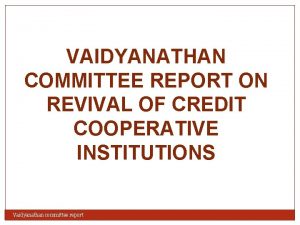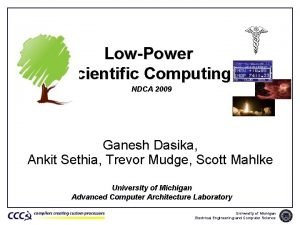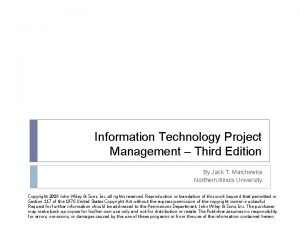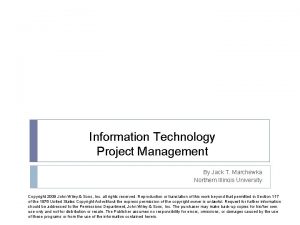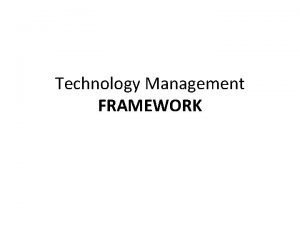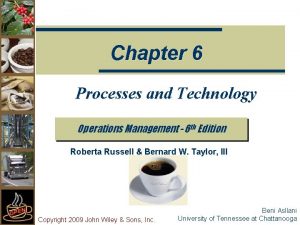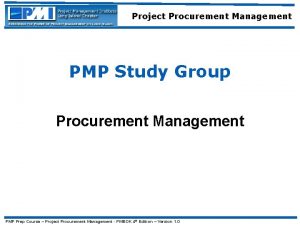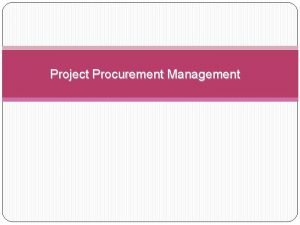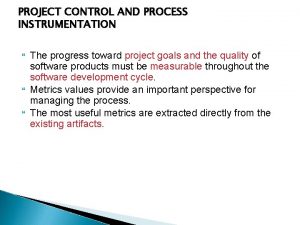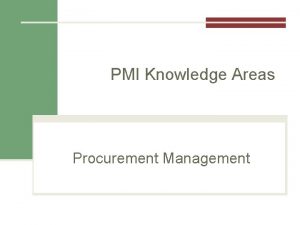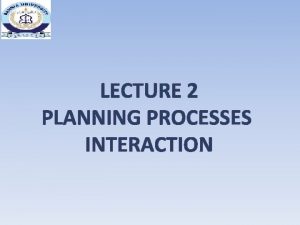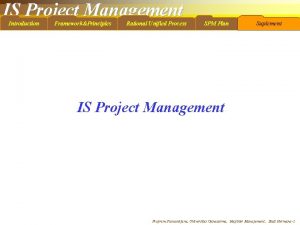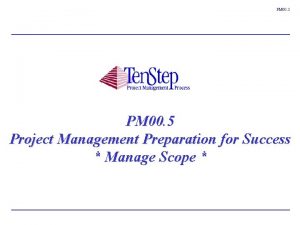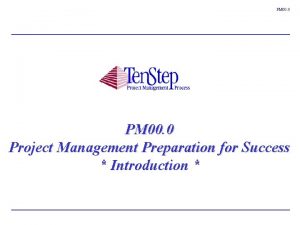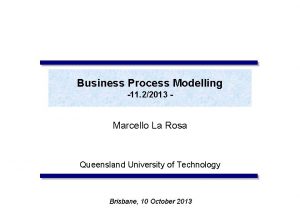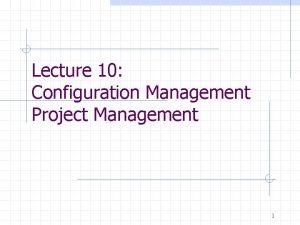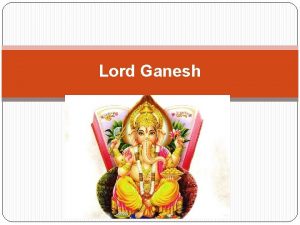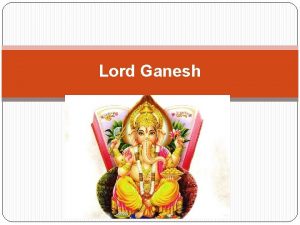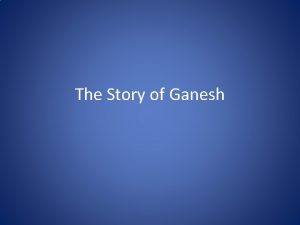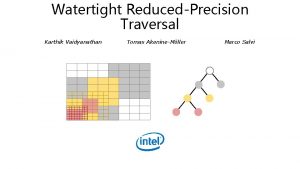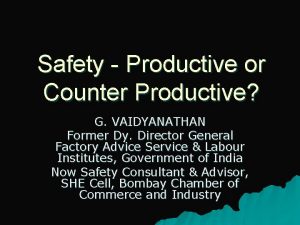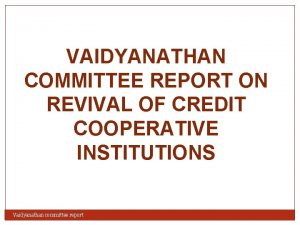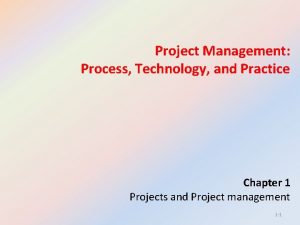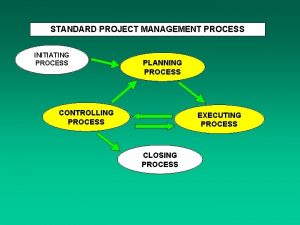Project Management Process Technology and Practice Ganesh Vaidyanathan




















































- Slides: 52

Project Management: Process, Technology, and Practice Ganesh Vaidyanathan Chapter 3 Project Management Tools 3 -1

Project Management Tools 3 -2

Project Management Tools Learning objectives § Describe various tools that are available for project managers § Explain how to brainstorm with your project team and come up with decisions § Explain how to use a Thought Process Map with a project team to represent the entire team’s thoughts, ideas, and questions relative to accomplishing the project goal § Explain how to use Quality Functional Deployment and understand customer requirements for scope development § Understand how to satisfy customers using the Kano Model § Summarize thoughts and ideas of the team using an affinity diagram 3 -3

Project Management Tools Learning objectives § Discuss how to find the cause and the effects of problems using fishbone diagrams § Explain how to use check sheets, Pareto charts, Nominal Grouping Techniques, and the Delphi technique in projects § Implement SWOT analysis and burndown charts § Understand various collaboration tools and project management software 3 -4

Project Management Tools Copyright © 2013 Pearson Education, Inc. Publishing as Prentice Hall 3 -5

Project Management Tools PM Tools Project process improvements contribute to the success of projects. Copyright © 2013 Pearson Education, Inc. Publishing as Prentice Hall 3 -6

Project Management Tools § § § § Tools Brainstorming Thought Process Map (TMAP) Quality Functional Deployment (QFD) Kano model Affinity diagrams Fishbone diagrams Check sheets Pareto charts Copyright © 2013 Pearson Education, Inc. Publishing as Prentice Hall 3 -7

Project Management Tools § § § Tools Nominal Grouping Technique (NGT) Delphi Technique SWOT analysis Burndown charts Communication and Collaboration Tools Project management software Copyright © 2013 Pearson Education, Inc. Publishing as Prentice Hall 3 -8

Project Management Tools Brainstorming § Teams often meet to generate ideas on any topic. § Brainstorming • Establishes an efficient process that is free of criticism and judgment. • Encourages open thinking among team members and involves all team members in the process. • Works well if team members build on each other’s creativity focusing on a single topic. • Collects team knowledge. § As a structured process • Team members provide ideas in turn. Copyright © 2013 Pearson Education, Inc. Publishing as Prentice Hall 3 -9

Project Management Tools Brainstorming § As an unstructured process • Team members provide ideas at random. § Individual team members paraphrase their ideas, clarify, and record them on a flipchart or board. Copyright © 2013 Pearson Education, Inc. Publishing as Prentice Hall 3 -10

Project Management Tools Brainstorming § Ring-Exchange Technique, originally named Method 635 • Six members sit around a table. • Team members generate three ideas and put them at the top of three columns on a sheet. • On command, the sheets are passed to the neighbor who tries to further develop the ideas. • New ideas are built on previous ideas in the same column. • Sheets are passed around five times and the time allotted for each round is limited to approximately five minutes. Copyright © 2013 Pearson Education, Inc. Publishing as Prentice Hall 3 -11

Project Management Tools TMAP § A graphical representation of a series of ideas or thoughts or decisions of a person or a team § An initial process for accomplishment of the project goals § A visual representation of an entire team's thoughts, ideas and questions relative to accomplishing the project goal § Should be one of the first tools employed when starting any project § Presents a structure of information and helps a team progress through the project process § A living document that will change throughout the project and has no set format Copyright © 2013 Pearson Education, Inc. Publishing as Prentice Hall 3 -12

Project Management Tools TMAP § A TMAP can be used to drive specific actions and select tools that are needed to complement those actions. § It also allows the team members to refer back to how, why, and when decisions were made. Copyright © 2013 Pearson Education, Inc. Publishing as Prentice Hall 3 -13

Project Management Tools TMAP Define the project goal(s) List the knowns, unknowns, and constraints Ask DMAIC questions and "grouped" questions Sequence and link all team comments, responses, and questions § Improve and link all responses to form a thought map § Identify possible tools to be used § § Copyright © 2013 Pearson Education, Inc. Publishing as Prentice Hall 3 -14

Project Management Tools TMAP § Define the project goal(s) Problem Statement: "Financial reports are late every month" Copyright © 2013 Pearson Education, Inc. Publishing as Prentice Hall 3 -15

Project Management Tools TMAP § List the knowns, unknowns, and Constraints Copyright © 2013 Pearson Education, Inc. Publishing as Prentice Hall 3 -16

Project Management Tools TMAP § Ask DMAIC questions and "grouped" questions Copyright © 2013 Pearson Education, Inc. Publishing as Prentice Hall 3 -17

Project Management Tools TMAP § Sequence and link all team comments, responses, and questions § Improve and link all responses to form a thought map Copyright © 2013 Pearson Education, Inc. Publishing as Prentice Hall 3 -18

Project Management Tools TMAP § Identify possible tools to be used Questions What metrics are used to measure performance? Do we have all necessary data in the financial system? Are the accounts in sync with all company activities? Responsible Completion Person Date XXX MM/DD/Y YYY Gather data on how late reports get ready Check all data in XXX monthly financials MM/DD/Y YYY Check General Ledger for errors MM/DD/Y YYY XXX Copyright © 2013 Pearson Education, Inc. Publishing as Prentice Hall 3 -19

Project Management Tools QFD § House of quality § A fundamental foundation in understanding customer requirements; links customer requirements to project planning, analysis, design, and implementation § Consists of six major components: • Customer requirements • Technical requirements • Planning matrix • Inter relationships • Technical correlations • Technical priorities, benchmarks, and targets Copyright © 2013 Pearson Education, Inc. Publishing as Prentice Hall 3 -20

Project Management Tools QFD Copyright © 2013 Pearson Education, Inc. Publishing as Prentice Hall 3 -21

Project Management Tools QFD § Determine, clarify, and specify customer needs in customer requirements component § Identify what customers want and how to satisfy these wants in technical requirements component § Complete planning matrix § Establish a connection between customer requirements and performance measures in interrelationships component § Complete technical correlations on the roof of the house of quality § Complete technical properties, set design targets and benchmarks Copyright © 2013 Pearson Education, Inc. Publishing as Prentice Hall 3 -22

Project Management Tools QFD Copyright © 2013 Pearson Education, Inc. Publishing as Prentice Hall 3 -23

Project Management Tools Kano Model § Distinguishes between three types of product requirements which influence customer satisfaction: • must-be requirements • one-dimensional requirements • attractive requirements Leather/colors Seats Heated Seats Copyright © 2013 Pearson Education, Inc. Publishing as Prentice Hall Automobile Seats 3 -24

Project Management Tools Kano Model § Must-be requirements: The customer will be extremely dissatisfied if these requirements are not fulfilled. Fulfillment of these requirements will not increase customer satisfaction as customers can take these requirements for granted. • Example: Brakes in an automobile. § One-dimensional requirements: Customer satisfaction is proportional to the level of fulfillment — the higher the level of fulfillment, the higher the customer satisfaction and vice versa. These requirements are usually explicitly demanded by the customer. • Example : Better fuel economy in an automobile. Copyright © 2013 Pearson Education, Inc. Publishing as Prentice Hall 3 -25

Project Management Tools Kano Model § Attractive requirements: These requirements have the greatest influence on customer satisfaction. They are neither explicitly expressed nor expected by a customer. If fulfilled, customers are very satisfied. There is no feeling of dissatisfaction if they are not met. These are of exciting quality to customers. • Example: Selection of attractive seat colors, real leather seats, bigger trunk space, power, and more storage space § Indifferent requirements: These requirements result in neither satisfaction nor dissatisfaction regardless of whether they are fulfilled or not. Customers just do not care. • Example: Various mechanical mechanisms to adjust the rear seat. Copyright © 2013 Pearson Education, Inc. Publishing as Prentice Hall 3 -26

Project Management Tools Kano Model § Reverse requirements: These requirements result in dissatisfaction when fulfilled and satisfaction when not fulfilled. • Example: Sinking feeling in some car seats. § In projects, Kano model can be employed to identify customer needs and functional requirements as well as during concept development. Copyright © 2013 Pearson Education, Inc. Publishing as Prentice Hall 3 -27

Project Management Tools Affinity Diagrams § Used to organize and summarize ideas or issues generated by team members § Organization of generated ideas and its summarization results in natural groupings of generated ideas so that the problem can be understood in its entirety § Allow ideas to become synergistic and work together by allowing groupings to emerge naturally to create unseen connections among ideas or issues § Encourage creativity by all team members Copyright © 2013 Pearson Education, Inc. Publishing as Prentice Hall 3 -28

Project Management Tools Fishbone Diagrams § Allow teams to identify and graphically detail all possible causes related to a problem and discover root causes of the problem at hand § Illustrate causes of a certain event § Identify potential factors that cause an overall effect; tool helps teams to focus on causes, not symptoms • At the outset, a problem statement should have been agreed upon by all team members. Ask team members to think about causes of the problem before the meeting. • Brainstorm with team all causes of the problem and construct the Cause and Effect (Fishbone) Diagram. Copyright © 2013 Pearson Education, Inc. Publishing as Prentice Hall 3 -29

Project Management Tools Check Sheets § Allow teams to systematically record and compile data from historical sources or observations as they happen in real time § Effective way of displaying collected data § Provide an organized structure for uniform data collection and collation § Procedure: • Team should agree with the definition of the events or conditions being observed • Decide who will collect the data, over what period, and from what sources • Design a Check Sheet that is easy to use Copyright © 2013 Pearson Education, Inc. Publishing as Prentice Hall 3 -30

Project Management Tools Pareto Charts § A simple bar graph where the y-axis represents frequency of occurrence and the x-axis represents the reasons § Arranged with the longest bars on the left and the shortest to the right so that the graph visually depicts which reasons are more significant § Used when analyzing data about the frequency of problems or causes in a process, when the most significant problem needs to be focused Copyright © 2013 Pearson Education, Inc. Publishing as Prentice Hall 3 -31

Project Management Tools Nominal Grouping Technique § A decision-making tool used to understand use the opinion of each and every project member § Provides more unique ideas, more balanced participation between group members, increased feelings of accomplishment, and greater satisfaction with idea quality and group efficiency Copyright © 2013 Pearson Education, Inc. Publishing as Prentice Hall 3 -32

Project Management Tools Nominal Grouping Technique § The project manager encourages each team member to share his or her ideas individually while recording each idea on a flip chart using the actual words spoken by that individual. Each record should be identified by a letter to enable team members to rank them at a later stage of this procedure. § Once all ideas are recorded on the flip chart, team members are encouraged to come up with ideas based on the already generated ideas. This part of the process ensures that all team members are given an opportunity to make equal contributions. § The project manager once again should record all new ideas generated by all team members. Copyright © 2013 Pearson Education, Inc. Publishing as Prentice Hall 3 -33

Project Management Tools Delphi Technique § This is a widely used tool to achieve aggregate opinions concerning real-world knowledge solicited from experts within certain topic areas. § Procedure: • Round 1: An open-ended questionnaire soliciting information about a specific content or problem or issue is designed. The questionnaire is sent to all those who have been identified as respondents, the DT participants. After receiving the responses, the collected information is used to design a well-structured questionnaire. This questionnaire is used as the survey instrument for the second round of data collection. Copyright © 2013 Pearson Education, Inc. Publishing as Prentice Hall 3 -34

Project Management Tools Delphi Technique § Round 2: • Based on the responses from the first round questionnaire, a summary of all results is collated by the project manager and a second questionnaire is designed. Each DT participant receives the second questionnaire and is asked to review and respond. The DT participants are also asked to rate or rank items to establish preliminary priorities among them. They are also asked to state the rationale concerning rating priorities among items. Using the results of round 2, areas of disagreement and agreement are identified. Usually in this round, consensus begins to form and the actual outcomes can be discovered among the responses. Copyright © 2013 Pearson Education, Inc. Publishing as Prentice Hall 3 -35

Project Management Tools Delphi Technique § Round 3: The results from second round are sent to the DT participants in the third round. Each DT participant receives a questionnaire that includes the items and ratings summarized by the investigators in the previous round. The DT participants are asked to revise their judgments or to specify the reasons for remaining outside the consensus. The third round provides an opportunity for the DT participants to make further clarifications in their responses. Prior research has concluded that a slight increase in the degree of consensus can be expected at the end of this round as the participants have the last chance to revise their judgments. Copyright © 2013 Pearson Education, Inc. Publishing as Prentice Hall 3 -36

Project Management Tools Delphi Technique § Round 4: The list of remaining items, their ratings, minority opinions, and items achieving consensus are distributed to the DT participants. This round provides a final opportunity for all participants to revise their judgments and provide any other feedback on the problem or issue at hand. Copyright © 2013 Pearson Education, Inc. Publishing as Prentice Hall 3 -37

Project Management Tools § § SWOT A strategic method for identifying whether to use a component or a feature in a project Commonly used tool for identifying gaps and potential for improvements in projects Internal strengths and weaknesses of a project External environmental opportunities and threats facing that project Copyright © 2013 Pearson Education, Inc. Publishing as Prentice Hall 3 -38

Project Management Tools SWOT § Procedure: • Establish objectives: The objectives of the project issue need to be clearly expressed. The purpose of conducting a SWOT analysis must be discussed at first with the team and a consensus to a clear topic must be attained. The scope of the topic may be wide, narrow, general, or specific. The project manager needs to establish that the final outcome of the SWOT analysis would emerge from contribution and discussion and not from personal views, no matter how much expertise the participants possess individually. Copyright © 2013 Pearson Education, Inc. Publishing as Prentice Hall 3 -39

Project Management Tools SWOT § Procedure: • Delegate research and information-gathering task: The project manager has to ask each participant in the SWOT analysis team to prepare all background information. This preparation is an important part of an effective SWOT analysis. The background preparation is gathering information on strengths and weaknesses of the project issue and should focus on the internal factors of skills, resources, assets, or lack of them. Opportunities and threats should focus on external factors over which the participants have little or no control, for example, social or economic factors. Copyright © 2013 Pearson Education, Inc. Publishing as Prentice Hall 3 -40

Project Management Tools SWOT § SWOT analysis: The project manager should call for a SWOT analysis meeting to discuss the findings of all participants. § Procedure: • List SWOT factors: List all the internal strengths and weaknesses of the project and the environmental opportunities and threats facing the project. • Evaluate SWOT factors against established objectives: Sort and group the listed SWOT factors in relation to the already established objectives. Use those SWOT factors to come up with new strategies, priorities, schedules, project selection, project organizational structure, and outsourcing of projects. Copyright © 2013 Pearson Education, Inc. Publishing as Prentice Hall 3 -41

Project Management Tools Burndown Chart § A graphical representation that is used to track the remaining work in a project and check whether the project deadline can be realized. § The chart is typically the work left to do versus the total scheduled time of an activity or an entire project. § The outstanding work, which represents the backlog, is on the vertical axis with total scheduled time along the horizontal axis. § This is a run chart of the outstanding work and is useful to predict when a project will be completed. § Burndown charts are used in the scrum process. Copyright © 2013 Pearson Education, Inc. Publishing as Prentice Hall 3 -42

Project Management Tools Burndown Chart § Procedure: • Arrange the data to start a burndown chart. • Make a line chart using days in the x-axis and the planned and actual balance of work in the y-axis. Copyright © 2013 Pearson Education, Inc. Publishing as Prentice Hall 3 -43

Project Management Tools Collaboration Tools § Lotus Domino http: //www. youtube. com/watch? v=kmg. Rnk 5 VSO 0 § Office Groove http: //office. microsoft. com/assistance/asstvid. aspx? assetid= XT 100627131033&vwidth=700&vheight=530&type=flash § MS Project http: //www. microsoft. com/project/en-us/demos. aspx Copyright © 2013 Pearson Education, Inc. Publishing as Prentice Hall 3 -44

Project Management Tools Project Tools Table 3. 3 Tool Selection Generating ideas Making Decisions Project Implementation Brainstorming TMAP QFD Kano Model Affinity diagram Fishbone diagram Check sheets Nominal Grouping Technique Delphi technique Pareto Charts SWOT analysis Burndown charts Collaboration Software Project Management Software Copyright © 2013 Pearson Education, Inc. Publishing as Prentice Hall 3 -45

Project Management Tools Summary § Brainstorming collects team knowledge and encourages open thinking among team members. This tool is used extensively in project management to involve all members and obtain input from all team members. § A Thought Process Map is a graphical representation of a series of ideas or thoughts or decisions of a person or a team to accomplish a project goal. It is the first tool to be employed when starting any project. This collaborative team effort is used to encapsulate all factors affecting a project. It is typically represented by information in a structured visual format that can be referred to throughout the project by the project team. Copyright © 2013 Pearson Education, Inc. Publishing as Prentice Hall 3 -46

Project Management Tools Summary § A TMAP is a visual representation of an entire team's thoughts, ideas, and questions relative to accomplishing project goals. § Quality Functional Deployment (QFD), also called the “house of quality, ” acts as a fundamental foundation in understanding customer requirements. It links customer requirements to project planning, analysis, design, and implementation. QFD uses a graphical format consisting of six major components: customer requirements, technical requirements, planning matrix, interrelationships, technical correlations, and technical priorities, benchmarks, and targets. Copyright © 2013 Pearson Education, Inc. Publishing as Prentice Hall 3 -47

Project Management Tools Summary § The Kano model distinguishes between five types of product requirements: must-be requirements, one-dimensional requirements, attractive requirements, indifferent requirements, and reverse requirements. These requirements influence customer satisfaction. § Affinity diagrams are used to organize and summarize ideas or issues generated by team members and allow ideas to work together by allowing groupings to emerge naturally and create unseen connections among ideas or issues. They also encourage creativity from all team members. Copyright © 2013 Pearson Education, Inc. Publishing as Prentice Hall 3 -48

Project Management Tools § § Summary Fishbone diagrams (also called Ishikawa diagrams or cause-and -effect diagrams) are graphical displays that illustrate causes of a certain event and allow teams to identify and graphically detail all possible causes related to a problem and discover root causes of the problem at hand. Nominal Grouping Technique (NGT) is a decision-making method for use among teams of many sizes. Delphi technique is used to bring consensus to a solution of a problem. SWOT analysis is a strategic method used to evaluate the strengths, weaknesses, opportunities, and threats involved in a project. A burndown chart is a chart of work left to do versus time. Copyright © 2013 Pearson Education, Inc. Publishing as Prentice Hall 3 -49

Project Management Tools Summary § Communication and collaboration tools help project team members to be in touch with each other regardless of their location. They help provide easy access and modifications to project documentation. Copyright © 2013 Pearson Education, Inc. Publishing as Prentice Hall 3 -50

Project Management Tools Class Discussions § Is brainstorming a better tool than all other tools that we discussed in this chapter? Why? § Can TMAP be used in projects that are on a very short schedule? Explain. § What does quality have to do with QFD? § To gather customer requirements, which is a better tool? QFD or Kano Model? Why not? Copyright © 2013 Pearson Education, Inc. Publishing as Prentice Hall 3 -51

Project Management Tools Class Discussions § At what point should we stop a Fishbone Diagram during its analysis? § What problems can be foreseen in an NGT way of attaining a decision? Can Delphi technique be used to help with NGT? § Can Project Management Software be used in small projects? Why or Why not? Copyright © 2013 Pearson Education, Inc. Publishing as Prentice Hall 3 -52
 Project management process technology and practice
Project management process technology and practice Vaidyanathan committee 2004
Vaidyanathan committee 2004 Dr geetha koushik
Dr geetha koushik Jaya vaidyanathan
Jaya vaidyanathan Traditional vs modern project management
Traditional vs modern project management Ganesh dasika
Ganesh dasika Osi tcpip
Osi tcpip Dr ganesh
Dr ganesh Ganesh dhakal
Ganesh dhakal Dr ganesh kadam
Dr ganesh kadam Ganesh thiagarajan
Ganesh thiagarajan Alex verstak
Alex verstak R. ganesh rajagopalan
R. ganesh rajagopalan Ganestalay india
Ganestalay india Jeffery ha
Jeffery ha Erik ganesh iyer søegaard
Erik ganesh iyer søegaard Dr ganesh das
Dr ganesh das Information technology project management 9th edition
Information technology project management 9th edition Blue project chapter 5
Blue project chapter 5 Information technology project management 8th edition
Information technology project management 8th edition Information technology project management 9th edition
Information technology project management 9th edition Information technology project management 9th edition
Information technology project management 9th edition Information technology project management
Information technology project management Information technology project management
Information technology project management Project management process group and knowledge area mapping
Project management process group and knowledge area mapping Technology management process framework
Technology management process framework What is process technology in operations management
What is process technology in operations management Final quality
Final quality The role of project management in achieving project success
The role of project management in achieving project success Walker royce software project management
Walker royce software project management When reducing project duration
When reducing project duration Modern project management began with what project
Modern project management began with what project Project evaluation in software project management
Project evaluation in software project management Perpetual project closure
Perpetual project closure Agile ms project template
Agile ms project template Project termination types
Project termination types Practice assessor feedback examples
Practice assessor feedback examples Project procurement management definition
Project procurement management definition Project procurement management process
Project procurement management process Process instrumentation in software project management
Process instrumentation in software project management Procurement management pmi
Procurement management pmi Demand management meaning
Demand management meaning What are the 7 steps of portfolio process?
What are the 7 steps of portfolio process? Interaction planning process
Interaction planning process Rational unified process project management
Rational unified process project management Ten step project management process
Ten step project management process Ten step project management
Ten step project management Process hierarchy in process management
Process hierarchy in process management Managing assets vs asset management
Managing assets vs asset management Configuration management in project management
Configuration management in project management Basic principles of cost management in project management
Basic principles of cost management in project management Configuration management in software project management
Configuration management in software project management Project integration management processes
Project integration management processes
